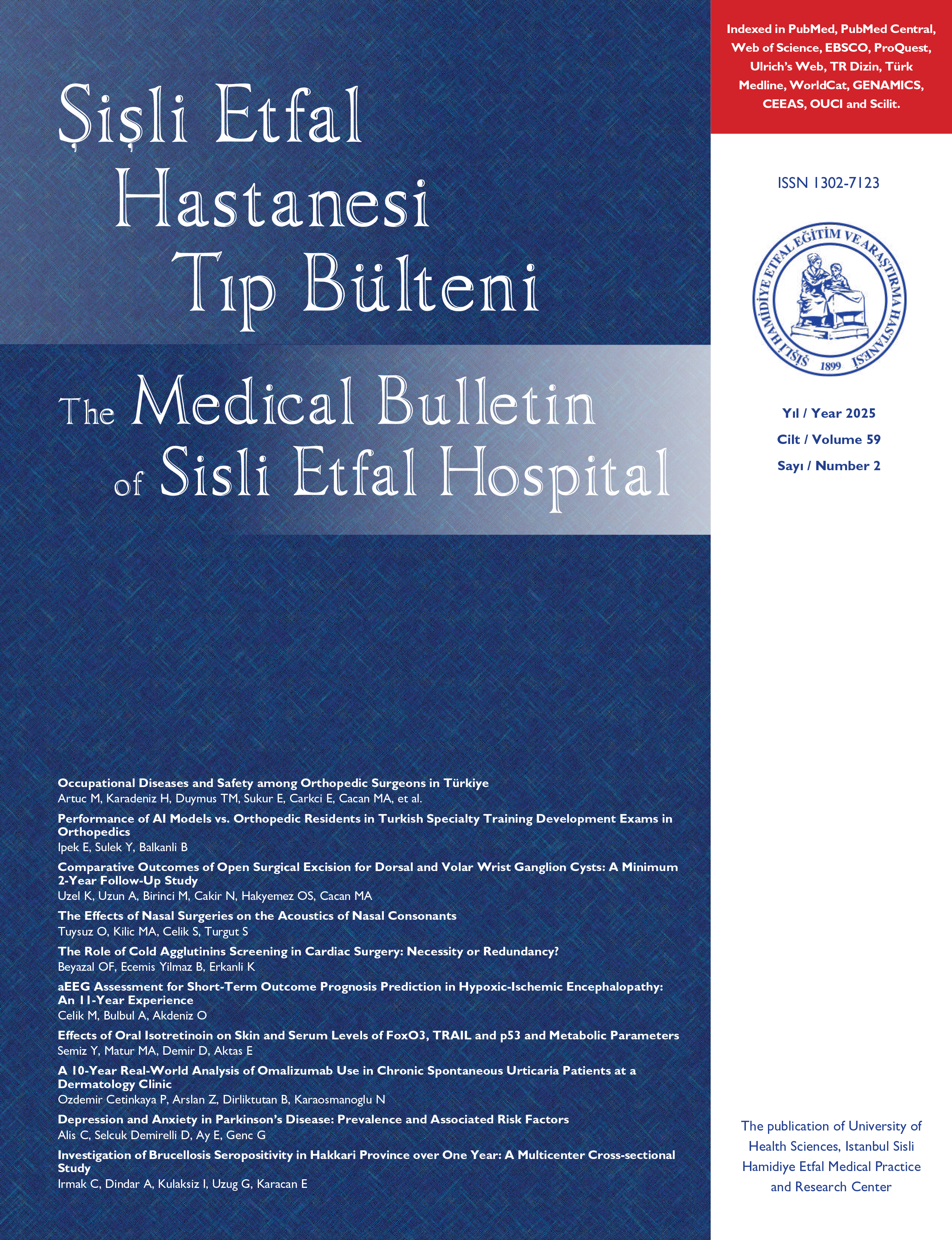
Primer Hiperparatiroidizmde Negatif Görüntüleme Sonucu ile Cerrahi Başarı Oranı İlişkisi
Mehmet Taner Unlu1, Mehmet Kostek1, Ozan Caliskan1, Tugba Ata Sekban2, Nurcihan Aygun1, Mehmet Uludag11Türkiye Sağlık Bilimleri Üniversitesi, Şişli Hamidiye Etfal Eğitim ve Araştırma Hastanesi, Genel Cerrahi Kliniği, İstanbul2Artvin Hopa Şehir Hastanesi, Genel Cerrahi Kliniği, Artvin
Giriş: Günümüzde halen primer hiperparatiroidi (pHPT)li hastalarda preoperatif negatif görüntülemenin cerrahi sonuçlar üzerine etkisi tartışmalıdır. Bu çalışmada preoperatif görüntülemenin cerrahi sonuçlara etkisini değerlendirmeyi amaçladık.
Materyal ve Metod: 2009-2018 tarihleri arasında opere edilen pHPTli hastaların verileri retrospektif olarak değerlendirildi. Hastalar sintigrafik ve/veya ultrason görüntüleme pozitifliğine göre 3 gruba ayrıldı: Grup 1; her iki görüntüleme pozitif, Grup 2; bir görüntüleme pozitif, Grup 3; her iki görüntüleme yönteminin de negatif olduğu hastalar. Grupların preoperatif biyokimyasal özellikleri, paratiroid patolojileri, patolojik bezin çapı ve hacmi, uygulanan ameliyat oranları, persistan ve reküren hastalık oranları karşılaştırıldı.
Bulgular: Ortalama takip süresi 24,7+18 olan ve yaş ortalaması 54,1+12,9 olan 311 hastanın (258K, 53E) 161I grup 1, 111i grup 2, 39u grup 3te yer almaktaydı. Grup 1de patolojik bez çapı (Grup 1, 2, 3te sırası ile 2.1±0.8, 1.6±0.9, 1.5±0.7 cm; p<0.001), patolojik bez hacmi (Grup 1, 2, 3te sırası ile 2±3.2, 1.4±2.9, 1.1±2.2 cm3; p<0.001), grup 3te çoklu bez hastalığı oranı (Grup 1, 2, 3te sırası 5.7%, 11%, 21%; p=0.024) anlamlı olarak daha yüksekti (p=0.024). Grup 1,2,3te bilateral eksplorasyon oranı sırası ile 93.2%, 48.6%, 5.1% olup, odaklanmış cerrahi veya unilateral boyun eksplorasyonu oranları sırası ile 6.8%, 51.4%, 94.9% olup fark anlamlı idi (p<0.001). İlk cerrahi sonrası grup 1,2,3te sırası ile kür oranı 91.3%, 93.7%, 89.7%, persistan hasta oranı 7.5%, 3.6%, 10,3% olup anlamlı fark yoktu. Persistan ve nüks hastalarda uygulanan ikincil girişim sonrası takip süresi sonunda toplam kür oranı sırası ile 97.4%, 96.4%, 97.4%, persistans hastalık oranı 1.3%, 1.8%, 2.6%, nüks
hastalık oranı 1.3%, 1.8%, %0 olarak saptandı.
Sonuç: pHPTli görüntüleme negatif olgularda cerrahi sırasında çoklu bez hastalığı olasılığı ve daha küçük patolojik bez olasılığının yüksek olabileceği göz önüne alınmalıdır. Görüntüleme negatif hastalarda cerrahi görüntüleme pozitif hastalar benzer ve kabul edilebilir kür oranı ile uygulanabilir. (SETB-2023-01-019)
Anahtar Kelimeler: Paratiroid cerrahisi, preoperatif görüntüleme, primer hiperparatiroidizm
The Relationship of Negative Imaging Result and Surgical Success Rate in Primary Hyperparathyroidism
Mehmet Taner Unlu1, Mehmet Kostek1, Ozan Caliskan1, Tugba Ata Sekban2, Nurcihan Aygun1, Mehmet Uludag11Department of General Surgery, University of Health Sciences Türkiye, Sisli Hamidiye Etfal Training and Research Hospital, Istanbul, Türkiye2Department of General Surgery, Artvin Hopa State Hospital, Artvin, Türkiye
Objectives: In present, the effect of pre-operative negative imaging results on surgical outcomes of primary hyperparathyroidism (pHPT) is still controversial. In this study, we aimed to evaluate the effect of pre-operative imaging on surgical outcomes.
Methods: The data of pHPT patients who were operated between 2009 and 2018 were evaluated retrospectively. Patients were divided three groups according to scintigraphy and/or ultrasonography results: Group 1; both imaging positive, Group 2; single imaging positive, and Group 3; patients in whom both imaging modalities are negative. Pre-operative biochemical characteristics, parathyroid pathologies, diameter and volume of the pathological gland, surgery rates, persistence, and recurrent disease rates of the groups were compared.
Results: Of 311 patients (258F, 53M) with a mean follow-up period of 24.7±18 months and a mean age of 54.1±12.9 years; 161 were in Group 1, 111 were in Group 2, and 39 were in Group 3. The diameter of pathological gland (2.1±0.8, 1.6±0.9, 1.5±0.7 cm; p<0.001; in Group 1,2,3 respectively) and the volume of pathological gland (2±3.2, 1.4±2.9, 1.1±2.2 cm3; p<0.001; in Group 1,2,3, respectively) in Group 1; the rate of multi gland disease (5.7%, 11%, 21%; p=0.024; in Group 1, 2, 3, respectively) in Group 3 were significantly higher. In the 1, 2, 3 group; bilateral exploration rates were 93.2%, 48.6%, and 5.1%, and focused surgery or unilateral exploration rates were 6.8%, 51.4%, and 94.9%, respectively, with a significant difference (p<0.001). After the first surgery, the cure rate was 91.3%, 93.7%, and 89.7%, and the persistent patient rate was 7.5%, 3.6%, and 10.3% in Groups 1,2,3, respectively, and there was no significant difference. At the end of the follow-up period after secondary intervention applied in persistent and recurrent patients, the overall cure rate was 97.4%, 96.4%, and 97.4%, persistent disease rate 1.3%, 1.8%, and 2.6%, recurrent disease rate 1.3%, 1.8%, and 0%, respectively.
Conclusion: In imaging-negative patients with pHPT, the possibility of multi gland disease and smaller pathological glands should be considered at the time of surgery. Surgery in imaging-negative patients can be performed with a similar and acceptable cure rate to imaging-positive patients.
Keywords: Parathyroid surgery, preoperative imaging, primary hyperparathyroidism
Makale Dili: İngilizce



















